
New Zealand, January 01999
The first days in the global South beckon a future return...
New Zealand has everything that a bicycle tourist could ever hope for. The country, at least most of it, seems to have been designed specifically with this activity in mind. That's why, in 01999, when I had an opportunity to choose a destination for a distant tour, it only took me a few minutes to decide on a visit to Aotearoa, The Land of the Long White Cloud.
The first thing to do when planning a bike tour of New Zealand. is to pick up copies of Nigel Rushton's Pedaller's Paradise guidebooks. I normally don't make much use of travel guidebooks, but these are the most useful I've ever seen, probably because they were written by a cyclist, for other cyclists. Small and light, but full of just what you need to have a good trip, these are essential.
It's my opinion, one that seems to be shared with others that have done similar trips, that the South Island offers the most enjoyable cycling conditions. But, I normally have a desire to see as much of an area as possible when I travel, so I planned out a visit that would cover both islands. The route is shown on the map below, beginning in Invercargill at the southern tip of the country, and heading generally to the northeast and Auckland.
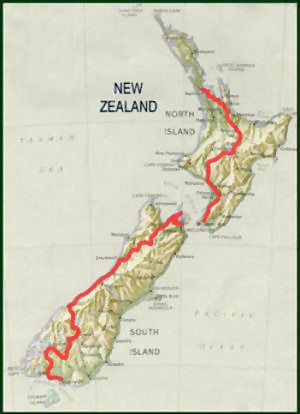
The first thing that you may notice about this route is that it leaves a fair bit of the country unexplored. This reveals the one big problem with this trip; it was too short! The reason for this was related to the reason that I was able to take this trip at all. To get across the vast Pacific, I used a free airline ticket from an airline bonus mile program (this was back in the days before I realized that these programs are a waste of time). It had taken me 15 years to build up enough travel to earn a ticket award, and now, just as I had one, most of the miles were set to expire in mid-January 1999. Due to a combination of airline blackout days, my work schedule, and the year-end holidays I could only arrange a visit of 17 days, from Dec 29 to January 16, which was obviously far too short. To make matters worse, once there I frequently met European tourists who had saved up their six weeks of annual vacation time over a few years and were making three-month tours of the islands. It was very frustrating, indeed. But 17 days would have to do this time, and I planned on enjoying every bit of it to the greatest extent possible.
Of course, one of the most tiring parts of this trip was the interminably long air trip. In my case this involved legs from; San Francisco to Los Angles, L.A. to Auckland, Auckland to Christchurch, and Christchurch to Invercargill, over a total of 21 hours. Fortunately the bike seemed to be in better sprits than I did after that ordeal. To pack up the bike I used my soft-sided travel case from BikePro and everything arrived in good shape. To solve one of the common problems when one uses a bike case and arrives and departs from different airports, I made use of an air cargo service to transport the empty case from Invercargill to Auckland. This worked out wonderfully. The cargo service at Invercargill offered to hold the case there for a couple of weeks and then send it of to Auckland, and the charge only came to about $US 30.00. Quite a good deal, I thought. At the end of the trip, there it was, waiting for me at the Auckland airport. After the long flight and taking care of this important detail, I was desperate to get on the bike and get moving. So, I packed up and rolled out of town, heading along the southern coast for a while towards the village of Te Tua.
The Roarin' Forties
Take a look at a map of the world. Notice, especially, the large patch of ocean that circles the globe in the Southern Hemisphere. Note, as well, that there are only two pieces of land which protrude into this expanse, Cape Horn at the tip of South America, and the bottom of New Zealand's South Island. This is the root cause of the Roarin' Forties, intense winds which have several thousand miles of open ocean to build strength before they slam into New Zealand. I encountered this phenomenon right out of the bat, and it plagued me for the first few days until I had moved north to a part of the island that has the good fortune to be somewhat sheltered by Australia. The photo below is me standing on the beach at Riverton on the shore of the Southern Ocean. The silly pose that I am in was meant to show the effect of the wind on my jacket. It doesn't really give the true effect.
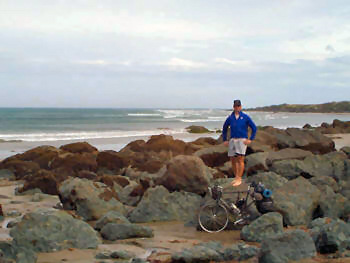
Over the right shoulder: Antarctica
Water, Beautiful Water
The next morning I began the first full day of the ride. The morning was misty and cool, and I was having a blast riding through almost deserted countryside. After a couple of hours, though, those mean winds started up again, and I was heading straight into them. This time I had a hard time coping with them, probably because, as a northerner, it was right in the middle of my natural "winter" so, my riding strength wasn't as good as it might have been. At one point, I stopped to rest and stretched out under a shady tree. Well, I must have dozed off, being so tired, and at some point the sun had come out and my feet, which were by then sticking out from under the shade of the tree, received a nice dose of ozone-hole enhanced solar-UV. Nothing left to do, but keep riding, sunburned feet and all. In the evening I struggled, hours later than I had planned, into the tiny town of Manapouri, where a nice meal got me revived a bit. Fortunately, at that time of year and at that latitude daylight lasts until almost 10:30 PM. So, I was able to cover a little more territory before dark and not fall too far behind my planned schedule. At that time, the wind had thankfully decided to shut down, and I began to fell a little better as I passed through the touristy town of Te Anau on the shore of the lake with the same name.
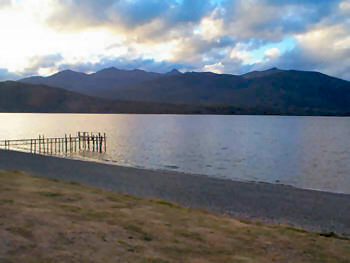
Lake Te Anau at Dusk
The geography of the southern part of South Island is dominated by numerous glacier-carved features. On the coast that means fjords (which, sadly, I didn't have time to visit), and inland long, beautiful lakes. In either case, water is everywhere and this combined with the rugged terrain makes for some truly spectacular cycling. The following day, I decided to power on and try and make up some of the time I had lost the day before. Turning inland for a while, I passed though the towns of Mossburn, Kingston and Frankton, near another touristy town, Queenstown. Here, the drier climate, in the rain shadow of the coastal mountains, reminded me of riding back home in California, and the large tour busses, which passed more frequently in that region, completed the picture. In that area, early one morning, I passed through the Kawarau Gorge, which is where the rather strange activity of Bungy Jumping originated. It was my "misfortune" to pass by at 7:30 AM, two hours before the jumping place opened. So, I had to settle for walking out onto the bridge they use, and looking over the side. Darn.
Later, while riding along the shore of Lakes Hawea and Wanaka, the demon winds returned and I lost some serious time again. This time they kept it up all night and kept me up most of it as well. In the photo below, you can see by the choppy water on the lake that they were still blowing at 7 AM the next morning.
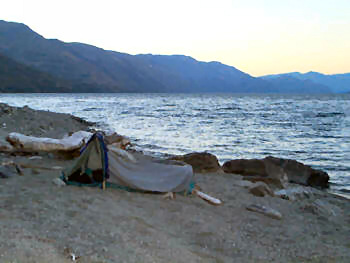
Early morning at Lake Wanaka campsite
The beautiful water features in this area are not limited to lakes and fjords. Amazingly clean rivers and stunning waterfalls are everywhere. There are so many of these that it was hard to keep moving at a reasonable pace. This also brought up one of the other difficulties of the trip. I realized that if I took a picture of every beautiful sight along the way, I would use up my camera's memory in the first few days. [Oh, how I wish I had one of my 4GB Flash cards back then] Time to start rationing pictures. Riding along the pretty Makarora river, I continued west towards Haast Pass. I have done a lot of mountain tours at home and was not looking to go up high on this trip, so the gentle climb up to Haast at 563m would be the high point on the South Island, The folks riding in the west-to-east direction had a much steeper grade than I did, however.
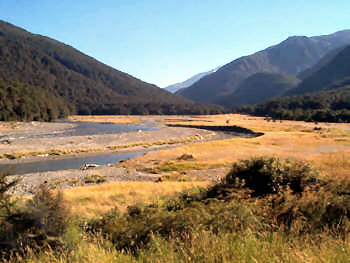
One of many: The beautiful Makarora River
The "Wet" Coast
The West Coast of South Island was one of the areas that I was most looking forward to seeing on this trip. One of the things that I enjoy the most about touring is seeing changing botanical and climatic areas as I travel. The West Coast of New Zealand is a temperate rain forest, largely composed of beech and tree ferns. This would be a very different experience from the coniferous forests of the western U.S. that I had been visiting recently. But would all the rain spoil the trip? It turned out to be my good fortune, if not the locals, that the country was having a drought that year. So, I rode the length of the coast with only a slight mist one morning
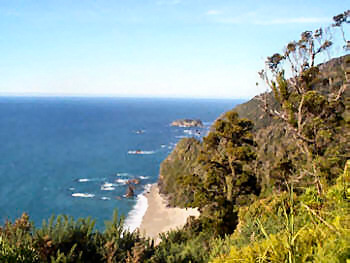
The beautiful coastline on the Tasman Sea
I had a fabulous time in this area. The strong headwinds of the early days had turned into gentle tailwinds, and physically, I had entered "The Zone" and was riding well. The scenery was wonderful, and the area is largely deserted except for the tourist areas at Fox and Franz Glaciers. There were just enough services to keep me well fed as I passed though the small towns of Haast, Fox and Franz, HariHari, and Hokitika before turning inland again as I swung though Greymouth. With my improved performance, I had also caught back up to my planned schedule. It was aslo nice to see tha numers other bike tourists in this area visiting from all parts of the world. The west coast of New Zealand certainly lives up to it's label as a cyclist's wonderland
The rest of the route on South Island was just about as nice. Passing through the pleasant town of Reefton lead to a spectacular ride through the Buller River valley and to an amazing campsite right next to Ariki Falls. A very rainy morning caused a delay in the town of Murchison, where several other tourists from Europe were also waiting out the weather. In the afternoon the skies cleared and a really fun ride followed to St Arnaud and Nelson Lakes National Park. Another of those glorious almost deserted backroads led to Nelson, the largest town I visited since leaving Invercargill. I took the opportunity to do some laundry and have a nice meal while there. A short bit of riding from Nelson lead to the Marlborough Sounds region where large estuaries bring the sea inland between thickly forested hills.
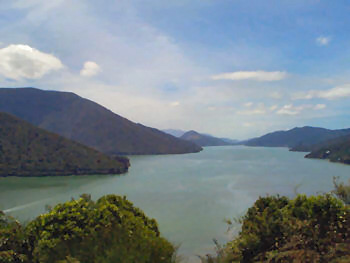
The Marlboro Sounds at the top of South Island
At the Sounds I had planned for a bit of a rest day. So, it was only a short ride in the morning out to the Mistletoe Bay campground, which is along the famed Queen Charlotte Track. In the afternoon I took the chance to do some "tramping" on the track through a forest filled with giant ferns. The photo below gives a good example of one of these. The tall skinny plants on the right that look like trees are also ferns, but their foliage is too high to make it into the picture.
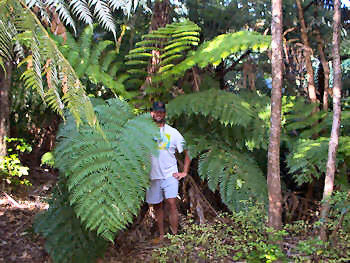
Dwarfed by a giant fern
Onward to the North Island
The ferry crossing to the north island departs from Picton, and there are two boats to choose from during the summer. I wish that I had taken the more leisurely InterIslander which is a traditional ferry taking several hours to cross the Cook Straight to Wellington. But, once again, because of my tight schedule I took The Lynx which is a fast hydrofoil-type ferry that takes only 2 hours 15 minutes to make the same trip. It was nice, but felt a bit like being on an airplane.
Wellington, the capital, is a whole different world from the South Island. Urban and busy, it is not a great place to ride. After having a heaping lunch, I did what a good tourist should, and took the commuter train out of the city as far as the town of Paraparaumu
In many ways the North Island seems much more like America than its more undeveloped southern companion. Even the local flora seemed more familiar. The area around Wellington looked eerily like the hills around San Francisco, with rolling brown hillsides covered with fennel and other familiar weeds. That other hallmark of America, automobile traffic, was more abundant as well. In fact, for those reasons, the section of the route from Paraparaumu north on Route 1 as far as the town of Bulls, was probably the only less-than-ideal segment of the entire tour.nbsp; In places, Rte. 1 was fairly narrow with a large amount of truck traffic. That made it seem too much I was like riding back home, a state of mind I usually try to avoid when out on tour.nbsp; I may have had a better time had I chosen Rte. 2 that also heads north from Wellington, but who knows? Time pressure, however, convinced me to take the shorter route to the west.
However, that may have turned out for the best, at least from a "Kiwi experience" point of view Just after dusk, as I settled down in my tent, I heard the most bizarre sound. It was a single, very loud, repetitive phrase that simply rose from a low to a higher pitch It seemed to be originating right outside my tent door, and went on for such a seemingly long time that I did not know if I would every get to sleep that night I couldn't see what was creating it, and could scarcely imagine what sort of creature could make such a piercing call (Here is a WAV recording of the sound, that I found on the Web.) I learned, after I returned home, that I was being entertained by a female Brown Kiwi, one member of the island's famous flightless bird family. Kiwis are increasingly rare, and so it is not surprising that most visitors never see one in the wild. I feel lucky now to have at least heard its cry, though a little amazed that such a loud sound could have been produced by such a small bird.
The next day the riding conditions calmed down again, and after I turned west onto Rte.3, I was back to having a fine time once more. That highway brought me to Wanganui, a pretty, small city, which had plenty of services, including a Big & Fresh supermarket, where customers are greeted by giant, singing, animatronic fruit as the enter the store. A surreal sight, to be sure, that made me feel that I was in Disneyland instead of Wanganui. Had I more time available, a rest day there may have been fun, but, instead, I resumed my route, traveling north on Rte. 4 towards the volcanic central highlands of the North Island.
This section of the route was quite pretty and surprisingly uncrowded. I was interested in seeing Mount Ruapehu and
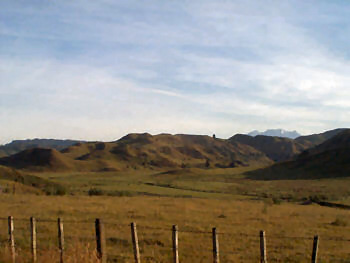
The countryside opens up on the North Island
Continuing on, I made my way north, passing thought the city of Rotorua.&nbasp; There, I visited the interesting geothermal area, and the Maori Cultural Center. These were both fun stops, and the concert of Maori music was wonderful. I had hoped to spend a little more time in the town, but the weather began to take a turn for the worse that afternoon, so I decided to move on, in case I was delayed a bit during the last couple of days. There was a moderate climb on Rte. 5 just after leaving town, and a few strong showers did make me wait for a while on the way up However, I managed to get close enough to be able to reach Auckland on time with only one full day remaining.
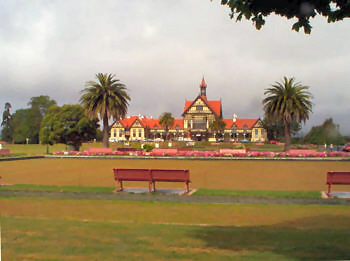
Governor's mansion museum in Rotorua
Home Too Soon
The final full day of the tour found me winding though the small towns and agricultural areas of the north-central part of North Island.&nbps; Shortly after morning, the weather cleared up, and I was able to dry out and really enjoy my last day. There was still a long way to go to get to Auckland and some strong headwinds made me feel a little more tired than I had wanted. So, when I reached the tiny settlement of Kaiaua, on the shore of the Firth of Thames, I took a room in a nice little Bed & Breakfast, which provided me with the only evening roof over my head that I had during the whole tour.
The water of the Firth was warm enough to comfortably swim there, and so I took a quick soak, something that I had been anxious to do for days, having been frequently turned away by the cold waters around South Island.My last day in the country was simply an early ride to Auckland to catch my afternoon flight home. The little roads that wound along the shoreline made for a nice approach to the edge of the country's largest city. I had neither the time, nor desire, to try and navigate though the city itself, however. So, when I reached the outskirts, at Papakura, I hopped on a city train, which easily accommodated both me and my bike. This took me to within a few kilometers of the airport, and that remaining distance was surprisingly easy cycling. I arrived in plenty of time to pick up my travel case, which was waiting in good condition, pack up the bike, and even take a nice shower in the terminal's public facilities.
I felt a little sad for having to take the long flight home so soon, but happy to have been able to visit that beautiful country at all, and to have successfully completed my goals while there. This was my first real experience touring outside of the United States, and I knew in my heart that it would not be my last. It was also the first time I had stepped onto the soil of a piece of Gondwanaland, though I did not realize at the time just how linked my future would become with that ancient land
Past Tours List
Main Index | Pre-Tour Index
Post-Tour Index | Articles Index
Slideshows
Main Page Methods Routes Hardware Oceans Past Tours |
Kiwi Cuisine
One of the most important factors of any long tour, which also may be one of the most enjoyable, is finding and devouring enough energy in the form of food to keep one's performance level high. It is probably the one time that foods that may not represent the smartest dietary choices can be consumed in satisfying quantities without concern. I certainly never pass up an opportunity to fill up on tasty treats, many of which I would never eat at home. So, I wondered as I prepared for my first overseas tour, whether I would have any problems feeding myself. Of course, given the culture and history of New Zealand, I expected that there would be no real problems in that regard. Nevetherless, every region has its unique culinary items, and I discovered some of these along the way.
One of the first things one notices while rolling through the countryside, is the lack of bovine residents found so frequently on ranches in other parts of the world. There are some occasional deer farms, but the stock that really takes the place of cattle are the sheep, for which the islands are so famous. They are omnipresent, and there distinctive bleating can be heard just about everywhere. However, these curly-coated residents are safe from finding themselves on the local menu, as their obligation to human culture is mostly limited to a forced donation of their thermally insulating coats to be spun into comfortable clothing.
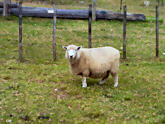
For wool, not for mutton
Meat is not absent from the menu, however. The New Zealand version of a burger is a huge meal and comes loaded with an eclectic collection of toppings including some surprises such as sliced beets. Much more commonly found is fried chicken. This was fortunate for me, as that is an item that I rarely eat at home, but, for some reason, is one of my favorites while on tour. This type of fare is easy to find in even the most diminutive towns at small restaurants called "takeaways" and is served wrapped in the previous day's newspaper. So, one gets fed and has a chance to keep up with current events at the same time.
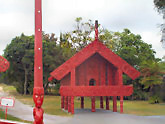
A Maori food storage shed
I found a few other distinctive traits to the food available on the islands. I often crave some salty crackers or chips after a long, warm day on the saddle. However, I found that while these items are readily available in most shops, they are prepared with a much lower salt content than what is common in the U.S. Though this is probably a big plus for the health of the Kiwis, it doesn't do too much to provide electrolytes a tired cyclist. Another, type of treat that I never eat at home, but relish on tour is any of the various forms of frozen dairy items. I really liked the vanilla ice cream pops that come coated with fruit puree. Also, delicious were the many flavors of milkshakes, though these need some further description. What is labeled a "milkshake" is more like a flavored milk drink, while a "thickshake" is more like the shakes that I grew up with.
It should also be noted that while you are enjoying the local food, you are also likely to become food. Not for any major predator, of course, but rather for the vast swarms of sandflies that will dine on your bodily fluids whenever they get the chance. It's probably the penalty that us off-islanders must accept in order to experience that beautiful country.
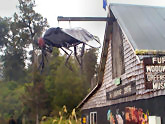
Watch out for Sandflies
Ride Log
December 31
Invercargill to Te Tua
Distance: 95 km
Roads: Rte.99
Conditions: Windy
January 01
Te Tua to E. of Te Anau
Distance: 123 km
Roads: Rte.99, Blackmount Rd, Rte.94
Conditions: Afternoon headwinds
January 02
E. of Te Anau to N. of Frankton
Distance: 167 km
Roads: Rte.94, Rte.6
Conditions: Pleasant
January 03
N. of Frankton to Lake Wanaka
Distance: 145 km
Roads: Rte.6
Conditions: Afternoon headwinds
January 04
Lake Wanaka to Lake Paringa
Distance: 159 km
Roads: Rte.6
Conditions: Afternoon tailwinds
January 05
Lake Paringa to Harihari
Distance: 150 km
Roads: Rte.6
Conditions: Afternoon tailwinds
January 06
Harihari to Ahaura
Distance: 142 km
Roads: Rte.6, Rte.7
Conditions: Morning mist
January 07
Ahaura to Ariki Falls
Distance: 115 km
Roads: Rte.7, Rte.69, Rte.6
Conditions: Pleasant
January 08
Ariki Falls to Golden Downs
Distance: 109 km
Roads: Rte.7, Rte.69, Backroad
Conditions: Morning Rain
January 09
Golden Downs to Rai Saddle
Distance: 98 km
Roads: Rte.6
Conditions: Pleasant
January 10
Rai Saddle to Mistletoe Bay
Distance: 70 km
Roads: Rte.6, Queen Charlotte Rd.
Conditions: Pleasant
January 11
Mistletoe Bay to Picton
Distance: 44 km
Roads: Queen Charlotte Rd.
The Lynx to Wellington
Train to Paraparaumu
Paraparaumu to Himitangi
Roads: Rte.1 (busy)
Conditions: Pleasant
January 12
Himitangi to S. of Raetihi
Distance: 148 km
Roads: Rte.1, Rte.3, Rte.4
Conditions: Pleasant
January 13
S. of Raetihi to Taupo
Distance: 165 km
Roads: Rte.4, Rte.47, Rte.1
Conditions: Pleasant
January 14
Taupo to Tapapa
Distance: 120 km
Roads: Broadlands Rd., Rte.5
Conditions: Occasional Showers
January 15
Tapapa to Kaiaua
Distance: 143 km
Roads: Rte.27, Rte.26, Rte.2, Clevedon Rd.
Conditions: Pleasant
January 16
Kaiaua to Papakura
Distance: 143 km
Roads: Clevedon Rd.
Train to Auckland Airport
Conditions: Pleasant
Total Distance
2091 km